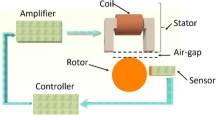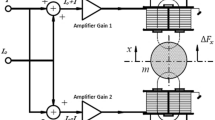Abstract
In this manuscript, to control and operate an open loop unstable active magnetic bearing (AMB) system, first a closed loop active magnetic bearing system is proposed. This proposed close-loop contains an algorithm-driven intelligently optimized PID controller, a power amplifier, a position sensor and the fabricated AMB system. Development of a hardware model of proposed AMB system is carried out in laboratory. Using its constructional parameters and after performing some experimental observations, a linearized open loop transfer function is determined by implementing mathematical linearization technique. For a nominal point of operation, the gain variables of PID controller are calculated on the basis of four different evaluation indexes using, firefly algorithm, grasshopper optimization algorithm and artificial bee colony optimization algorithm. These evaluation indexes are: integral of absolute error, integral of squared error, integral of time multiplied absolute error and integral of time multiplied squared error. Further, a comparison among these optimization techniques is realized on three scale: transient state performance, observed statistical data and time taken in execution of algorithm. The efficacy and utility of the optimization techniques are demonstrated by computational calculations and a thorough study of the acquired data.



















Similar content being viewed by others
References
Castellanos Molina LM, Bonfitto A, Galluzzi R (2021) Offset-Free Model Predictive Control for a cone-shaped active magnetic bearing system. Mechatronics 78:102612. https://doi.org/10.1016/j.mechatronics.2021.102612
Schweitzer G, Maslen EH (2009) Magnetic bearings: theory, design, and application to rotating machinery, vol 1. Springer, Berlin
Schweitzer G, Bleuler H, Traxler A (1994) Basics, properties and applications of active magnetic bearings. Act Magn Bear 210:1–112
Schweitzer G (2002) Active magnetic bearings-chances and limitations. In: 6th international conference on rotor dynamics, pp 1–14
Hoshi H, Shinshi T, Takatani S (2006) Third-generation blood pumps with mechanical noncontact magnetic bearings. Artif Organs 30(5):324–338
Akamatsu T, Nakazeki T, Itoh H (1992) Centrifugal blood pump with a magnetically suspended impeller. Artif Organs 16(3):305–308
Wroblewski AC, Sawicki JT, Pesch AH (2012) Rotor model updating and validation for an active magnetic bearing based high-speed machining spindle. J Eng Gas Turbines Power. https://doi.org/10.1115/1.4007337
Smirnov A, Uzhegov N, Sillanpää T, Pyrhönen J, Pyrhönen O (2017) High-speed electrical machine with active magnetic bearing system optimization. IEEE Trans Ind Electron 64(12):9876–9885
Zhang C, Tseng KJ (2013) Design and control of a novel flywheel energy storage system assisted by hybrid mechanical-magnetic bearings. Mechatronics 23(3):297–309. https://doi.org/10.1016/j.mechatronics.2013.01.008
Bangcheng H, Shiqiang Z, Xi W, Qian Y (2011) Integral design and analysis of passive magnetic bearing and active radial magnetic bearing for agile satellite application. IEEE Trans Magn 48(6):1959–1966
Zhang K, Zhu R, Zhao (2002) Experimental research on a momentum wheel suspended by active magnetic bearings. In: Proc. 8th ISMB, Mito
Masuzawa T, Ezoe S, Kato T, Okada Y (2003) Magnetically suspended centrifugal blood pump with an axially levitated motor. Artif Organs 27(7):631–638
Jiang D et al (2020) Novel topologies of power electronics converter as active magnetic bearing drive. IEEE Trans Ind Electron 8(2):34833–34841. https://doi.org/10.1109/ACCESS.2020.2974765
Chen M, Knospe CR (2005) Feedback linearization of active magnetic bearings: current-mode implementation. IEEE/ASME Trans Mechatron. https://doi.org/10.1109/TMECH.2005.859824
Debnath S, Biswas PK, Laldingliana J (2017) Analysis and simulation of PWM based power amplifier for single axis Active Magnetic Bearing (AMB). In: 2017 IEEE Transportation Electrification Conference (ITEC-India), pp 1–5
Larsonneur R, Siegwart R, Traxler A (1992) Active magnetic bearing control strategies for solving vibration problems in industrial rotor systems
Knospe CR (2007) Active magnetic bearings for machining applications. Control Eng Pract. https://doi.org/10.1016/j.conengprac.2005.12.002
Mazenc F, de Queiroz MS, Malisoff M, Gao F (2006) Further results on active magnetic bearing control with input saturation. IEEE Trans Control Syst Technol 14(5):914–919
Turek M, Březina T (2007) State controller of active magnetic bearing. https://doi.org/10.1007/978-3-540-73956-2_19
Zhang P, Zhang J (2022) Lower limb exoskeleton robots’ dynamics parameters identification based on improved beetle swarm optimization algorithm. Robotica 40(8):2716–2731. https://doi.org/10.1017/S0263574721001922
Luo X, Yuan Y, Chen S, Zeng N, Wang Z (2022) Position-transitional particle swarm optimization-incorporated latent factor analysis. IEEE Trans Knowl Data Eng 34(8):3958–3970. https://doi.org/10.1109/TKDE.2020.3033324
Lin C-T, Jou C-P (2000) GA-based fuzzy reinforcement learning for control of a magnetic bearing system. IEEE Trans Syst Man Cybern Part B 30(2):276–289. https://doi.org/10.1109/3477.836376
Couzon P-Y, Der Hagopian J (2007) Neuro-fuzzy active control of rotor suspended on active magnetic bearing. J Vib Control 13(4):365–384
Shata AMA-H, Hamdy RA, Abdelkhalik AS, El-Arabawy I (2018) A fractional order PID control strategy in active magnetic bearing systems. Alex Eng J 57(4):3985–3993. https://doi.org/10.1016/j.aej.2018.01.020
Dhyani A, Panda MK, Jha B (2018) Moth-flame optimization-based fuzzy-PID controller for optimal control of active magnetic bearing system. Iran J Sci Technol Trans Electr Eng 42(4):451–463
Bo W, Haipeng G, Hao L, Wei Z (2021) Particle swarm optimization-based fuzzy PID controller for stable control of active magnetic bearing system. J Phys Conf Ser 1888(1):12022
Debnath S, Biswas PK (2021) Design, analysis, and testing of I-type electromagnetic actuator used in single-coil active magnetic bearing. Electr Eng 103(1):183–194. https://doi.org/10.1007/s00202-020-01071-x
Laldingliana J, Biswas PK, Debnath S (2017) Magnetic analysis of single-axis active magnetic bearing using ANSYS base. environment, vol 4, no 11, pp 169–174
Debnath S, Biswas PK (2021) Advanced magnetic bearing device for high-speed applications with an I-type electromagnet. Electr Power Components Syst 48(16–17):1862–1874
Yang X-S (2010) Nature-inspired metaheuristic algorithms. Luniver Press
Gandomi AH, Yang X-S, Alavi AH (2011) Mixed variable structural optimization using firefly algorithm. Comput Struct 89(23–24):2325–2336
Abd-Elazim SM, Ali ES (2018) Firefly algorithm-based load frequency controller design of a two area system composing of PV grid and thermal generator. Electr Eng 100(2):1253–1262. https://doi.org/10.1007/s00202-017-0576-5
Yang X-S (2009) Firefly algorithms for multimodal optimization. In: International symposium on stochastic algorithms, pp 169–178
Yang X-S (2010) Firefly algorithm, Levy flights and global optimization. In: Research and development in intelligent systems XXVI. Springer, pp 209–218
Yang X-S (2013) Multiobjective firefly algorithm for continuous optimization. Eng Comput 29(2):175–184
Ezugwu AE, Akutsah F (2018) An improved firefly algorithm for the unrelated parallel machines scheduling problem with sequence-dependent setup times. IEEE Access 6:54459–54478
Yang X-S, Hosseini SSS, Gandomi AH (2012) Firefly algorithm for solving non-convex economic dispatch problems with valve loading effect. Appl Soft Comput 12(3):1180–1186
Severin S, Rossmann J (2012) A comparison of different metaheuristic algorithms for optimizing blended PTP movements for industrial robots. In: International conference on intelligent robotics and applications, pp 321–330
Chatterjee A, Mahanti GK (2013) Minimization in variations of different parameters in different φ planes of a small-size concentric ring array antenna using firefly algorithm. Ann Telecommun des télécommunications 68(5):299–306
Saremi S, Mirjalili S, Lewis A (2017) Grasshopper optimisation algorithm: theory and application. Adv Eng Softw 105:30–47
Luo J, Chen H, Xu Y, Huang H, Zhao X (2018) An improved grasshopper optimization algorithm with application to financial stress prediction. Appl Math Model 64:654–668
Mirjalili SZ, Mirjalili S, Saremi S, Faris H, Aljarah I (2018) Grasshopper optimization algorithm for multi-objective optimization problems. Appl Intell 48(4):805–820
Mokeddem D (2021) Parameter extraction of solar photovoltaic models using enhanced Levy flight based grasshopper optimization algorithm. J Electr Eng Technol 16(1):171–179
Taher MA, Kamel S, Jurado F, Ebeed M (2019) Modified grasshopper optimization framework for optimal power flow solution. Electr Eng 101(1):121–148. https://doi.org/10.1007/s00202-019-00762-4
Ewees AA, Gaheen MA, Yaseen ZM, Ghoniem RM (2022) Grasshopper optimization algorithm with crossover operators for feature selection and solving engineering problems. IEEE Access 10:23304–23320. https://doi.org/10.1109/ACCESS.2022.3153038
Xu Z et al (2021) Spiral motion mode embedded grasshopper optimization algorithm: design and analysis. IEEE Access 9:71104–71132. https://doi.org/10.1109/ACCESS.2021.3077616
Gozde H (2015) Comparative analysis of swarm optimization-based control method for direct matrix converter. Electr Eng 97(3):181–193. https://doi.org/10.1007/s00202-014-0327-9
Zhou H et al (2020) An improved Grasshopper optimizer for global tasks. Complexity 2020:1–23
Meraihi Y, Gabis AB, Mirjalili S, Ramdane-Cherif A (2021) Grasshopper optimization algorithm: theory, variants, and applications. IEEE Access 9:50001–50024. https://doi.org/10.1109/ACCESS.2021.3067597
Abualigah L, Diabat A (2020) A comprehensive survey of the Grasshopper optimization algorithm: results, variants, and applications. Neural Comput Appl 32:1–24
Zhao R, Ni H, Feng H, Song Y, Zhu X (2019) An improved grasshopper optimization algorithm for task scheduling problems. Int J Innov Comput Inf Control 15(5):1967–1987
Liang H, Jia H, Xing Z, Ma J, Peng X (2019) Modified grasshopper algorithm-based multilevel thresholding for color image segmentation. IEEE Access 7:11258–11295
Karaboga D (2005) An idea based on honey bee swarm for numerical optimization. Technical report-tr06, Erciyes University, Engineering Faculty, Computer
Akay B, Karaboga D (2012) Artificial bee colony algorithm for large-scale problems and engineering design optimization. J Intell Manuf 23(4):1001–1014
Karaboga D, Gorkemli B, Ozturk C, Karaboga N (2014) A comprehensive survey: artificial bee colony (ABC) algorithm and applications. Artif Intell Rev 42(1):21–57. https://doi.org/10.1007/s10462-012-9328-0
Eroğlu H, Aydin M (2018) Solving power transmission line routing problem using improved genetic and artificial bee colony algorithms. Electr Eng 100(3):2103–2116. https://doi.org/10.1007/s00202-018-0688-6
Karaboga N (2009) A new design method based on artificial bee colony algorithm for digital IIR filters. J Frankl Inst 346(4):328–348
Rajasekhar A, Jatoth RK, Abraham A (2014) Design of intelligent PID/PIλDμ speed controller for chopper fed DC motor drive using opposition based artificial bee colony algorithm. Eng Appl Artif Intell 29:13–32
Mernik M, Liu S-H, Karaboga D, Črepinšek M (2015) On clarifying misconceptions when comparing variants of the artificial bee colony algorithm by offering a new implementation. Inf Sci (NY) 291:115–127
Karaboga D, Akay B (2007) Artificial bee colony (ABC) algorithm on training artificial neural networks. In: 2007 IEEE 15th Signal Processing and Communications Applications, pp 1–4
Ozturk A, Cobanli S, Erdogmus P, Tosun S (2010) Reactive power optimization with artificial bee colony algorithm. Sci Res Essays 5(19):2848–2857
Samanta S, Chakraborty S (2011) Parametric optimization of some non-traditional machining processes using artificial bee colony algorithm. Eng Appl Artif Intell 24(6):946–957
Suri B (2011) Review of artificial bee colony algorithm to software testing. Int J Res Rev Comput Sci 2(3):706
Ercin O, Coban R (2011) Comparison of the artificial bee colony and the bees algorithm for pid controller tuning. In: 2011 international symposium on innovations in intelligent systems and applications, pp 595–598
Tavazoei MS (2010) Notes on integral performance indices in fractional-order control systems. J Process Control 20(3):285–291
Dorf RC, Bishop RH (2008) Modern control systems. Pearson Prentice Hall
Astrom K (1995) PID controllers, theory, Des. tuning
Author information
Authors and Affiliations
Corresponding author
Ethics declarations
Conflict of interest
The authors declare no conflict of interest to disclose.
Additional information
Publisher's Note
Springer Nature remains neutral with regard to jurisdictional claims in published maps and institutional affiliations.
Rights and permissions
Springer Nature or its licensor (e.g. a society or other partner) holds exclusive rights to this article under a publishing agreement with the author(s) or other rightsholder(s); author self-archiving of the accepted manuscript version of this article is solely governed by the terms of such publishing agreement and applicable law.
About this article
Cite this article
Gupta, S., Debnath, S. & Biswas, P.K. Control of an active magnetic bearing system using swarm intelligence-based optimization techniques. Electr Eng 105, 935–952 (2023). https://doi.org/10.1007/s00202-022-01707-0
Received:
Accepted:
Published:
Issue Date:
DOI: https://doi.org/10.1007/s00202-022-01707-0




